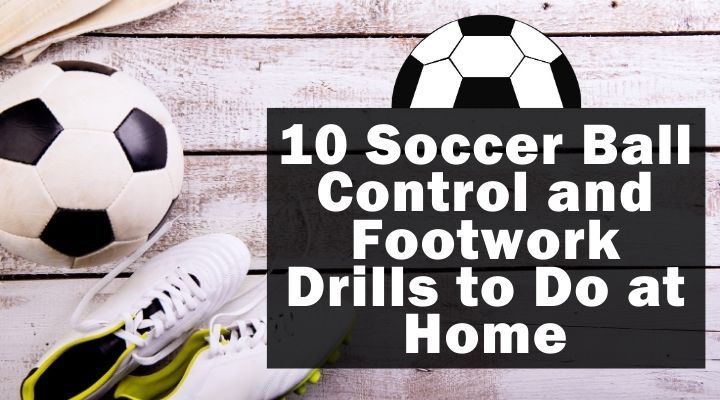12 Soccer Ball Control and Footwork Drills (2024 Update)
If you want to be the best player you can be, then you're going to want to spend as much time as possible training and honing your skills.
This means not only turning up to every training session and match but also practising at home, in your backyard, or on any available space every free moment you get.
Thankfully, there are loads of great soccer ball control drills you can do by yourself that will hone your first touch, improve your agility, and work on your dribbling and footwork.
Here are 10 awesome soccer ball control drills and footwork drills that you can do at home.
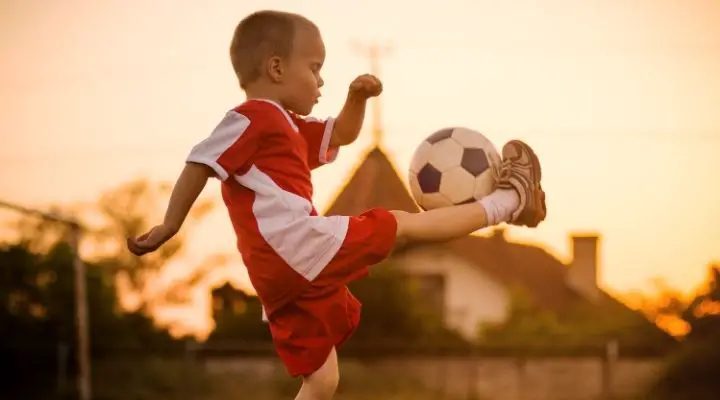
12 Soccer Ball Control Drills
While developing a great first touch and close ball control skills is key to being good at soccer, focusing on your footwork is just as important as the two are so closely interlinked.
By working on your agility, balance, dexterity, speed, and power, you'll not only enhance your conditioning and control over your body but your touch, technique, and footwork, too.
This will not only help the ball stick to your foot but allow you to kill the ball with one touch and deftly dribble your way past your opponent and win invaluable space and time out on the pitch.
Now that we've seen why it’s so important to work on your ball control and footwork, let's take a look at some great drills that you can do at home, in your garden, or on any space that you have available.
1. Juggling
A great way to improve your control and technique is to practice juggling and try and keep the ball in the air for as long as possible.
Besides being loads of fun, it helps you work on your touch with not only your feet, thighs, and chest but your head, too.
To start, you can either flick the ball up into the air or drop it from your hands and start juggling from there.
Make sure to take short, sharp touches, get in a rhythm, and try and retain your balance and control over your body as much as possible.
Keep your knees slightly bent and lean slightly over the ball to retain the most control over it.
If you want to make juggling more challenging, there are loads of things you can do such as only keeping it in the air with your weaker foot or just using your head.
Another alternative is to kick the ball high up into the air and then try and deftly control it with your feet, thighs, or chest when it comes down.
This mimics game situations and allows you to develop a very close ball control for whatever comes your way out on the pitch.
2. Wall Passes
Another excellent drill for working on both your ball control and footwork as well as your passing and striking technique is to do wall passes.
This sees you kick a ball against the wall and control the rebound before striking it again, passing, and controlling it for as long as you want.
To start, stand a couple of metres from the wall and strike the ball, readying yourself at the same time for the rebound coming your way.
Make sure to remain on your toes so that you can react quickly and deftly kill the ball before striking it again.
Focusing on your passes is just as important as your first touch as a good pass will help you better control the ball.
Again, there are absolutely loads of fun and creative ways to make wall passes more of a challenge.
For instance, you can vary the distance at which you stand and the power at which you strike the ball or only allow one-touch passes or passes with your weaker foot.
Another option is to vary the height of your passes so that it brings your thighs and chest control into the game or even juggle against the wall and see how long you can keep the ball in the air.
3. Target Practice
Again using a wall, you can enhance your accuracy, striking technique, and footwork by setting up a target for you to aim at.
This fun exercise sees you either visualise a place on the wall that you want to hit or put cones, jumpers, or a marker against the wall for you to aim at.
For this target practice drill, you want to stand a bit further back from the wall and either strike the ball with your laces or go for a placement shot with the interior of your foot.
To be as accurate and powerful as possible, make sure to focus on your footwork so that you strike the ball cleanly.
Start with the ball in a stationary position before moving on to some more challenging variations when you feel more confident.
After mastering the stationary shot, it’s well worth working on some other variations that can help you to either improve your one-touch shooting or your ball control skills and fleet footwork, too.
Besides striking the ball from a stationary position, you can dribble around a cone or two before unleashing your shot.
Another option is to first pass the ball at the wall and then control it, setting yourself up for the shot with that one touch.
Alternatively, you can first pass the ball at the wall and then directly shoot at your intended target from the rebound.
4. Heading
As they come up so often in matches, it’s also a good idea to practice your heading skills at home, focusing on your footwork and control of where the ball goes as you do.
With this drill, you can either throw the ball against a wall, ask a family member to throw it to you, or launch it directly up in the air yourself.
With all of these options, you then want to judge and time your leap and connection to perfection, cushioning or powering the ball in the direction you want it to go.
To get as much height on your leap as possible, you want to time your run and jump to perfection, pushing off of your stronger leg and using your arms to propel you towards the ball.
Remember to direct the ball where you want it to go with your head and keep your arms to either side of you to help hold any incoming challenge.
Key to arriving at the ball at the right height and time is your footwork which needs to be set up correctly for you to spring powerfully towards the ball.
Besides varying the distance and height that the ball travels before you head it, you can also vary up the target you’re aiming at to make the exercise more challenging.
Instead of heading it forwards, try powerfully heading it to either side, focusing on your control and accuracy of the header and your footwork as you do.
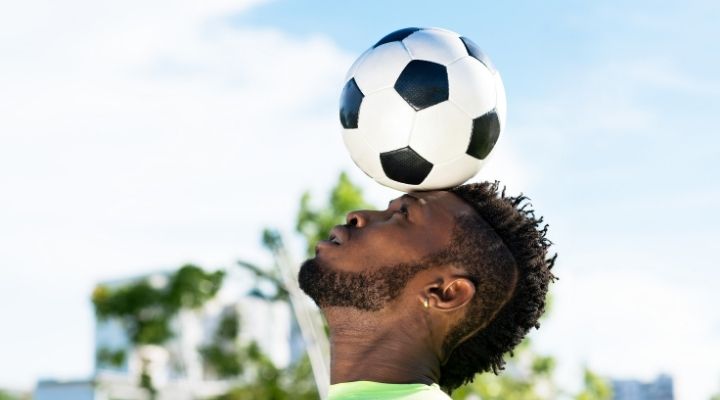
5. Dribbling
A fantastic way to improve both your close ball control skills and footwork at the same time is to practice dribbling at home around some cones.
This exercise also helps with your agility, coordination, and balance as well as your speed and change of direction.
To start, simply set up a line of cones and dribble around them, taking small, deft touches to take the ball between them.
Make sure to use both your feet as you do this and try and use both the inside and outside of each one, building up speed as you gain in confidence.
Again, there are lots of variations to this drill that can make it more complicated and challenging once you feel confident in your dribbling abilities.
For instance, it’s a good idea to set up a few cones to either side or end of the line so that you have to sprint or switch direction with the ball.
This helps you not only practice dribbling in small spaces but also prepares you for quickly bursting away from an opponent with the ball, retaining your close control and touch at the same time.
Another option is to dribble around the cones only using your weaker foot or just the outside of your feet.
6. Toe-Taps
To help speed up your footwork as well as increase your balance, coordination, and conditioning, it’s well worth doing some toe-taps when you have time at home.
This drill sees the ball remain stationary on the ground as you place one foot on top of the ball before taking it off and switching foot.
While it sounds easy, the coordination and concentration you need to keep the ball in place make this much tougher than it seems while ramping up the speed only adds to the challenge.
To make it even harder, rotate around the ball as you do the toe-taps, putting your footwork to the test as you do so.
7. Rollover Dribble
Another exercise that helps you improve both your close ball control and dribbling skills is the rollover dribble.
It also enhances your footwork as well as your touch and technique.
With this drill, there are loads of different variations you can do with the idea being that you use the sole of your feet to control the ball and manoeuvre it to where you want it to go.
One version sees you stand in place and simply roll the ball between your feet, using only the soles to do so.
The quicker you go, the tougher it gets.
Another option is to dribble through a line of cones using the rollover dribble, speeding up as you gain in confidence.
Once you have mastered the move and built up your speed and touch, try doing the rollover dribble but backwards!
This sees you roll the ball between the soles of your feet, dragging it back with you as you backpedal backwards.
8. The Inside Out
Great for improving your coordination, control, and footwork is the inside out.
Very useful for when you're out on the pitch, this exercise will help you nimbly skip away from opponents while keeping the ball close to you at all times.
To do the drill, simply start with the ball at your feet.
With one of them, push the ball with the outside of your foot just a step or two to the side of you.
With the same foot, you then want to stop the ball with the inside of it, tapping it back in the way it came.
With your other foot, you now want to do the same move but in the opposite direction.
The idea is that you go in and out in a fluid motion, keeping the ball close to both the insides and outsides of your feet as you go.
To make the drill more challenging, simply increase the speed at which you do the exercise as this will put your footwork to the test.
Another option is just to increase the length of time you do the inside out as your concentration will start to drop the longer you go and the more tired you get.
Yet another alternative is to do the drill in the same way but pull the ball back with your toes once it’s to the outside of you.
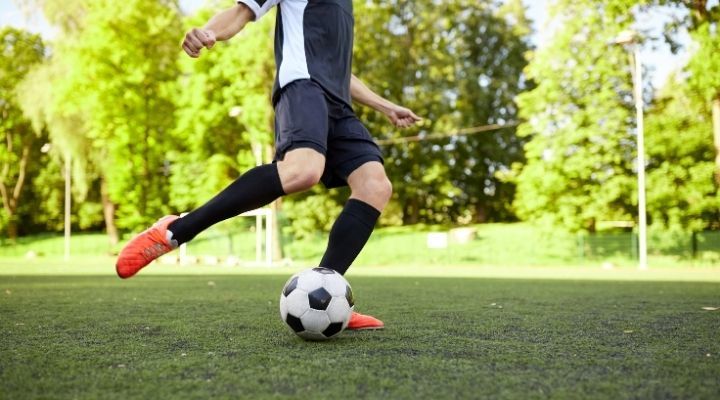
9. The Cruyff
Somewhat in the same vein as the inside out is the Cruyff which will challenge your control and coordination.
Besides improving your footwork, this drill will also help with your agility, balance, and dexterity.
As with the inside out, you want to push the ball with the outside of your foot to one side of you.
The difference between the two is that instead of bringing it back towards you in the same manner, you want to do a Cruyff Turn.
This sees you again cushion the ball back in the same direction with the same foot but instead take it behind your standing leg.
You then again repeat the process with your opposite foot.
Once you feel confident doing the Cruyff, try and speed up your footwork as much as possible.
This will enable you to turn on a penny and evade the close marking of any opponent out on the pitch.
10. The L Cut
Another awesome drill for enhancing your close ball control and footwork is the L Cut which again hones your touch and technique.
This one’s great for dragging the ball away from a defender's despairing challenge and changing the direction in which you’re going.
With this exercise, you want to again start with the ball at your feet.
With one foot, you drag the ball back and towards the side with your studs, at the same time opening your body out and cushioning the ball forwards slightly with the interior of your foot.
This move should make a small 'L' shape.
You then want to grab the ball with the studs of your other foot and complete the same move and shape in the opposite direction before repeating the process several times.
With the L Cut, you again want to increase your speed while focusing on getting your footwork just right, making sure to keep close control over the ball.
Try and do it for as long as possible to really put your abilities to the test.
11. Wall Pass Drag Backs

The next drill is essentially an advanced version of the wall passes drill from above.
Although the regular wall pass drill is an awesome exercise for improving your passing, first touch, and reactions, this version includes an extra movement that will improve your game significantly on game day.
Rather than hitting a first-time pass back to the wall or taking a touch and passing, this drill involves a drag back, as if you were moving away from an opponent.
Here’s what you do.
Place a cone around five yards from the wall.
Stand to the left of the cone with the ball at your feet.
Play a firm pass to the wall and wait for it to come back to you.
When it does, take a touch to control it.
Next, use the sole of your cleat to drag the ball backward, behind the cone. Then, flick the ball to the other side of the cone using the outside of your foot, and shuffle across.
Take one touch to move the ball ahead of the cone, then replicate the same process from the other side.
Repeat this over and over again for two-minute rounds. Take a break, then repeat until it becomes second nature.
This drill is particularly useful for midfielders and attackers. The cone represents an opposition defender. The drag back, sideways shuffle, and repositioning combination is an effective way to evade a defender in a tight space.
Although you don’t want players trying this move all the time, it’s an excellent piece of skill for receiving the ball and creating space under pressure.
12. Speed Weave
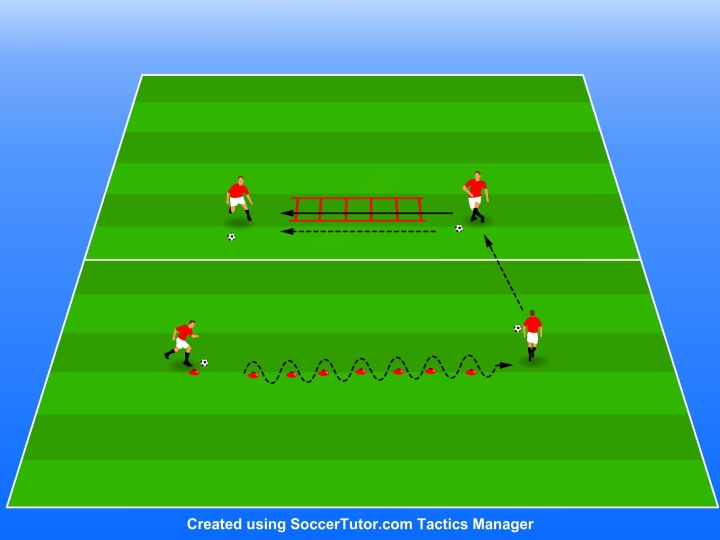
There’s no better place to improve your foot speed than in your backyard. It’s the perfect place to practice footwork drills that you might not perform regularly on the training field.
In this drill, cones and an agility ladder come in handy.
However, if you don’t have either, find something you can use instead of cones, such as spare shoes, plant pots, sweaters, or other soccer balls.
Create a seven or eight-cone dribbling weave. Next to it, lay down your agility ladder.
If you don’t have cones or a ladder, create a weave using your cone substitutes. Instead of a ladder, use your cone substitutes to mark a start and finish point that lines up with the cone weave.
Here’s how the drill goes.
Stand at one end of the cone weave with the ball at your feet.
Start by dribbling through the wave as quickly as you can.
When you complete the weave, dribble to the end of the agility ladder.
At the bottom of the agility ladder, gently pass the ball to the other end, aiming to for the ball to stop rolling at the top.
As the ball is rolling, run through the agility ladder with high knees, ensuring both feet enter every gap.
When you reach the end of the ladder, get the ball, dribble back to the cone weave, and repeat.
If you don’t have a ladder, just perform high knees from the start point to the end as if there were a ladder there.
Repeat the drill for two minutes, take a break, and then go again.
Not only is this a great drill to improve your dribbling and footwork, but it’s also great for building stamina.
Conclusion:
Besides going to every training session and turning up to every match your team plays, it’s well worth working on some extra soccer ball control drills and footwork drills at home.
In addition to improving your touch and technique, these exercises will enhance everything from your agility and balance to coordination, concentration, and conditioning.
By putting in the extra work and hours in your spare time at home, you'll certainly improve your soccer skills which will only lead to even more phenomenal performances out on the pitch.
Drills for Teams: 10 Soccer Dribbling Drills for Dominant Ball Control
Further Reading: 123 Soccer Drills for All Ages and Skill Levels (With Images)

